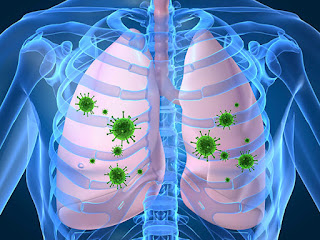Cancer drug in
the treatment of tuberculosis
The World Health Organization
estimates that more than one-quarter of the world's population is currently
infected with tuberculosis. Tuberculosis is
world’s deadliest infectious diseases. There are
various types of drugs are discovered to treat tuberculosis which is cause by Mycobacterium tuberculosis. Recently researchers
have discovered an FDA-approved drug that has been designed to treat cancer
helps to fight against tuberculosis in mouse models. This drug is an MMP
inhibitor that designed to increase the structural integrity of blood vessels
in tumours so that other drugs can reach inside them. It performs the same
function as in the granulomas associated with tuberculosis so that antibiotics
can reach the bacteria sheltering within.
Matrix metalloproteinase (MMPs)
are naturally produced by animals that break down connective tissue for a wide
array of biological processes such as wound repair, growth and tissue
development. An increased in the
production of MMPs has been strongly linked to the growth and metastasis of
tumours. Many drugs have been created to inhibit MMP production, but have
proven largely unsuccessful in the treatments to slow cancer progression in
clinical trials.
In a new study, show that these
drugs may be more useful in treating tuberculosis. These results show that
several MMP inhibitors, including the FDA-approved drug Marimastat, increase
the structural integrity of leaky blood vessels in tuberculosis granulomas,
allowing antibiotics to penetrate them and attack the tuberculosis pathogens in
mice more efficiently.
When M. tuberculosis enters
the lungs, the immune system attempts to contain the bacterial colony by
forming a cut around it which is called as granuloma.
Tuberculosis is one of oldest pathogens. It has evolved a very clever strategy
to survive. These granulomas are meant to destroy tuberculosis; the bacteria up
regulates host MMPs to remodel the interior part of the granuloma, to gain
protection from the immune system and antibiotics.
The M. tuberculosis remains
as dormant within these granulomas for decades until something triggers them to
become active. Once this get active, the disease becomes contagious again and
kills roughly 15 percent of those who reach this stage.
Tuberculosis is extremely
difficult to kill even in its active stage, requiring a six-to-nine month regimen
of antibiotics. As many people are struggling to stick with treatment for that
long time, especially after symptoms have subsided, strains resistant to
multiple types of antibiotics are emerging. This is the most important reason
to define the ways of curing the diseases.
A number of different types of
small molecule MMP inhibitors increased the effectiveness of anti-tuberculosis
drugs in killing the infectious disease in mouse models. Since tuberculosis is
a most common infectious diseases in today world’s world so its treatment is
necessary for the survival of people. Bacterial
diseases 2018 help in this field to define a new path for treatment of this
type of infections.







